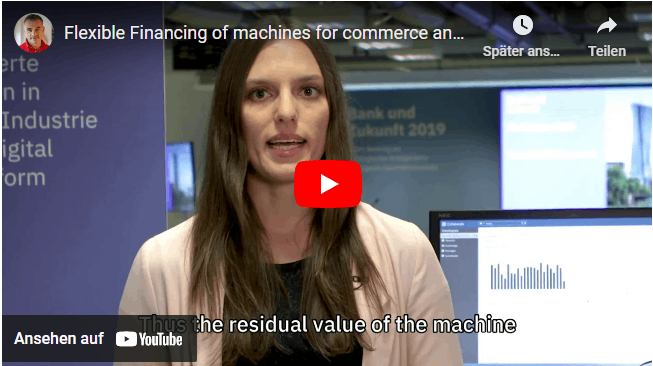
Due to the increasing digitization of machines and systems, data instead of steam is now the driving force for innovations in the industrial sector. Banks can benefit from this evolution and the resulting networking of business processes – for example, if they analyze usage data in real time and on this basis offer their customers tailored financing.
Producing more and more efficiently: With this goal in mind, industry is building new machines and production systems in the digital age. The financing of these technical facilities is also undergoing a significant change with regard to digitization, since connecting the machines to the Internet enables the determination of insightful production figures and sharing these with third parties, such as financial service providers. Based on this data, banks can create new financing offers for industrial customers and thus add new, dynamic pay-per-use products to their portfolio. This becomes possible through the use of technologies that quickly and intelligently process the valuable resource 'data'.
About Industry 4.0 and the Internet of Things
The fourth industrial revolution, Industry 4.0 for short, denotes the comprehensive digitization of the industrial sector. Following steam and electricity, it is now primarily algorithms and data that drive innovations such as the automation of production processes or smart machines.
An elementary component of Industry 4.0 is the Internet of Things (IoT). This term refers to the networking of objects via the Internet. In this way, the objects can communicate and interact directly – with their surroundings or with each other. The exciting thing is that these are no longer just the typical smart devices such as computers or smartphones – today cars, refrigerators or wind turbines are also busy providing data.
In the industrial context, IoT (here often referred to as the Industrial Internet of Things – IIoT) is used when machines and operating systems are equipped with sensors and networked with one another. With the help of information technology, this exchange creates so-called cyber-physical systems: data-based networks from which valuable information can be extracted. This allows industrial enterprises to register figures and control events automatically to optimize processes in production and manufacturing.
IoT Changes the Requirements for Financial Institutions
IoT has already conquered both private life and industry: everything is connected. Financial institutions can practice banking of things and thus develop new business models in the corporate customer segment. With the digitization of industry, the requirements of bank customers in the corporate sector have also changed. Today, financial service providers are expected to make faster credit decisions and create individually tailored financing offers for trade and industry. So far, however, hardly any innovative financing models have been used, although the demand is constantly increasing. Banks must take these needs seriously in order to remain competitive, because IoT-specialized Fintechs are ahead of them when it comes to technological adaptation.
 Customized, flexible corporate financing is a customer request that has not yet been met to the necessary extent and that is becoming increasingly important, as the study Financing Models in the Context of Industry 4.0 by ibi research from 2019 (only available in German) asserts: "On the financial markets [there is] a clear discrepancy between financing requirements for modern, efficient and sustainable machines and production systems based on new technologies on the one hand, and financial investment requests from medium- and long-term investors on the other. This mismatch is […] costly and can inhibit the further development towards Industry 4.0 or put companies at a significant disadvantage in competition".
Customized, flexible corporate financing is a customer request that has not yet been met to the necessary extent and that is becoming increasingly important, as the study Financing Models in the Context of Industry 4.0 by ibi research from 2019 (only available in German) asserts: "On the financial markets [there is] a clear discrepancy between financing requirements for modern, efficient and sustainable machines and production systems based on new technologies on the one hand, and financial investment requests from medium- and long-term investors on the other. This mismatch is […] costly and can inhibit the further development towards Industry 4.0 or put companies at a significant disadvantage in competition".
Aiming to provide an overview of the current status and future financing models in the context of Industry 4.0, the authors of the report asked 90 experts from various industries about the greatest challenges for financial service providers when it comes to corporate banking and Industry 4.0. The answers show that solutions for the development and integration of new business models related to Industry 4.0 and the development of a suitable platform strategy are still missing: 41 percent identified business models, 34 percent platform strategy, and 32 percent product development as tasks that still need to be solved.
Opportunities of IoT Networking for Banks
In corporate finance today, the definition of credit rates and residual values for machines and systems is linear and static over a financing period. However, every industrial company is subject to seasonal and economic fluctuations. They need financing solutions that take these aspects into account.
Financial institutions can also be integrated into the value chains networked by IoT, for example, in the manufacturing or energy industry. Manufacturers make their data from the production process accessible, such as the operating time of the machine or the number of goods produced. It is now up to banks to use this information as the basis for new business models and personalized services.
A customer-oriented cost proposal could develop like this, for example: The machines to be financed are either indirectly (via the manufacturer of the machine) or directly connected to the banking system and transmit their usage data. Based on this data, the bank can offer a flexible, usage-synchronized payment model. Such pay-per-use models can be used to compensate for seasonal and cyclical fluctuations, which protects the company's liquidity. In the same way, loan contracts can be shaped by data: the repayment amount can be calculated based on actual utilization.
With individualized corporate financing, financial institutions do not just receive a crucial and unique selling point that considers the needs of the company. The know-your-customer principle is also served by the company's constantly updated data analyses. Nevertheless, it is important to define a strategy and a technology to implement the digital network between bank and corporate customer. An example illustrates how the use of a banking platform can facilitate usage-based financing in an industrial environment.
Implement Customized Financing Models with a Digital Banking Platform
A company from the manufacturing industry buys a machine. For the calculation of dynamic financing, the number of times the machine is used per day is to be transmitted. To simulate this, in our example a robot solves a Rubik’s Cube and transmits the usage data to a demo bank in real-time.
With the help of a banking platform, the machine data can be received and processed by the bank. The software displays the usage data received for the current month and automatically depicts the average and minimum repayment amount. Based on the term, the monthly repayment trend can be viewed.
Using the underlying business functionality, the platform prepares the data immediately. It contains the necessary business logic, which enables the platform to determine the current payment based on the daily workload and calculate the residual value of the machine in real time. Since the data is always kept up to date, an adjusted financing rate can be issued dynamically. The seasonal fluctuations and set-up times that are common in the industrial sector are also taken into account. For banks, the regular assessment of the data means better risk monitoring, and automatic data analysis and preparation means more precise risk assessment, for example in lending. Industrial customers avoid a liquidity bottleneck in times of low load.
Conclusion
Whether they calculate rates for repayment plans or evaluate the residual value in real time – one advantage of automated, intelligently networked solutions is that they serve to develop new business models in the Industry 4.0 environment. Beyond this, they allow banks to extend their value chain, for example, when leasing or financing vehicles, by enabling them to include all kinds of information: be it the number of goods produced, the hours the machine has been used, or the kilometers traveled. This makes a banking platform a universal tool in times of IoT and big data.
A platform solution, as shown in the example, makes data manageable and it makes individualized financing solutions possible in the first place. The added customer value generated by offering such a dynamic payment model ultimately gives the bank a clear competitive advantage and optimized margins.
Sources:
Video: Flexible Financing of Machines for Commerce and Industry with IBM. (Thomas Bohn / YouTube).
Teaser: Zapp2Photo – 675942252 – iStock.










